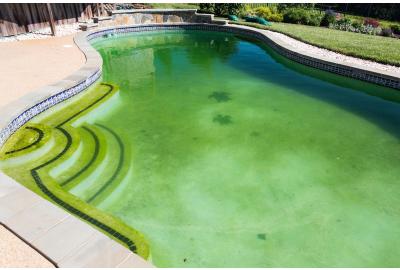Different types of Algae
Is your pool green? This could be caused by algae growth. But what exactly is algae and how does it grow?
Algae are aquatic, plant like organisms. However, they do not have the traditional roots, stems and leaves that make up a normal plant. So, without these traditional plant-like structures how does algae grow? Algae grows through photosynthesis. This is the process in which light is transformed into energy that is used to convert water and carbon dioxide into oxygen. Therefore, Algae is likely to grow faster when exposed to more sunlight.
Different types of Algae
The four most common types of algae that could be found in a swimming pool are green, yellow, pink, and black algae.
Green Algae
Green algae are the most common type of algae that is found in swimming pools. It can grow on the walls and floor of the pool or it can float in the water. Green algae can often infest the entire pool over night or in a matter of hours, especially after very hot days, after a high bather load, or when there is not enough sanitiser in the water.
Have you noticed more algae in the pool after a heavy rain storm? This is because lightning creates nitrogen in the atmosphere which then gets washed into the swimming pool with rain water. Nitrogen is not only a food source for algae, but it also breaks down chlorine, lowering the water’s sanitation.
Yellow Algae
Yellow or mustard algae are similar to green algae; However, Yellow algae doesn’t grow as fast as green algae. This slow growing process makes it difficult to destroy yellow algae because it can’t be identified as quickly as green algae. Yellow algae are low on chlorophyl which gives it the yellow colour. Since chlorophyl thrives on light, yellow algae is likely to grow in darker areas of the pool.
Pink Algae
Pink algae are a type of bacteria that commonly grows around PVC pipes and in darker areas of the pool. Pink algae are generally harmless and relatively easy to remove with the use of Aqua Pro Algaecide and Oxidiser.
Black Algae
Black algae are generally easy to avoid however, they are very difficult to remove once they start growing. Black algae tend to grow in areas such as corners or parts of the deep end where there is insufficient circulation. This makes it almost impossible to remove black algae because it is harder for the algaecide and sanitiser to reach those areas.
To remove algae, follow this easy step-by-step process.
Follow this step-by-step process to remove green algae:
- Always remember to get the basics right first: Test the water; clean out the weir and pump baskets; backwash and rinse. This is to ensure that you obtain the best results from the products added. Learn more here.
- With the pool system on bypass/circulate, add your Aqua Pro Algaecide through the weir, followed by the Aqua Pro Oxidiser.
- After the oxidizer has been added, the pool may become cloudy. Run the filter for 12 hours.
- Add the Aqua Pro Clarifier for a crystal-clear pool. Learn more here.
Contact a professional at The Pool Team for further advice on your personalised algae solution.

